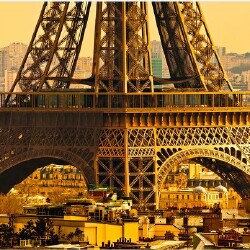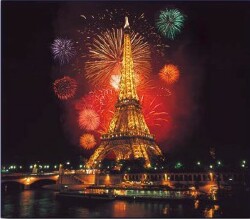Group tours to Paris inevitably include a must-see visit to the Eiffel Tower, synonymous with the city of Paris. It is the most visited  landmark in the world with nearly 7,000,000 people from every corner of the globe each year. Designed by Gustave Eiffel, who won the bid out of 107 bidders, and built in 1889 for the Universal Exposition to commemorate the centenary of the French Revolution, the iron-clad structure attests to its roots in infrastructure technology during the 19th century. It stands a whopping 324 meters high (1063 feet), with three levels, at a total weight of 22,000,000 pounds (10,100 tons).
landmark in the world with nearly 7,000,000 people from every corner of the globe each year. Designed by Gustave Eiffel, who won the bid out of 107 bidders, and built in 1889 for the Universal Exposition to commemorate the centenary of the French Revolution, the iron-clad structure attests to its roots in infrastructure technology during the 19th century. It stands a whopping 324 meters high (1063 feet), with three levels, at a total weight of 22,000,000 pounds (10,100 tons).
A 360 degree, panoramic view of Paris is seen from the Eiffel Tower. The tower is illuminated in the evenings, and it sparkles with breathtaking vibrancy for 10 minutes every hour on the hour until 1:00 am each evening.
Each of the three levels offers a slightly different perspective overlooking Paris, each with a different admission price. The first level is 190 feet above the ground, the second- 380 feet, and the third- 900 feet. The first level is open and currently undergoing renovation, while boasting boutiques, restaurants, and even a cinema showcasing the history of the Eiffel tower. For visitors with children aged 6-10, a kid-friendly host named Gus helps these little tourists to learn about the Tower’s history. The second level offers 3 souvenir shops, and places to eat, including the well-known, modern and chic, “Jules Verne” restaurant. Reservations highly recommended. The third level shows a wax-figure reconstruction of Eiffel’s office. At the summit there is also a champagne bar, and interesting facts about La Tour Eiffel, such as how much paint is used every seven years to repaint the tower (60 tons).
The best views from the tower can be seen after dark, when the City of Lights shows its finery. Views of the city are often clearer and better defined without the haze of the daylight, and the lines of people waiting to go up are less long. Overlooking the Iena Bridge on one side and the beautiful Champs de Mars on the other, the Tower is the background setting to the most beautiful display of fireworks
display every national holiday, the 14th of July. A stroll along the Seine River invariably keeps the Tower in view. One of the nicest images of it is from the Mirabeau Bridge, where once can capture both the Tower and the miniature Statue of Liberty, which is posted on the Grenelle Bridge.
The Eiffel Tower is an incredible feat of architecture. Initially expected to last a mere 20 years, it has stood for more than 120 years, and has become the symbol of France/ Hours: every day from 9am to 11pm, and until 12 midnight during the summer. Metro stops: Bir-Hakeim, or Alma; Trocadero; RER-C Champs de Mars. Take a virtual tour HERE.

 Wondering where the French president lives and works? Right in the middle of Paris, in the Elysée Palace. In 1718, a town house was constructed on a plot of land in the then-sleepy area of Paris known as the Faubourg St-Honoré to serve as the residence of the Count of Evreux. Built and decorated between 1718 and 1722, the house was designed and laid out in accordance with the prevailing principles of contemporary architectural theory. At his death in 1753, the Comte left a town house that was admired by all his contemporaries, one of whom called it the finest country home in the neighbourhood of Paris. Passed on through the ages to various owners and occupiers, regal, powerful, socially connected and revolutionary, the palace has been transformed, redecorated, remodeled, modernized. In 1848, it was designed the official residence of the French president. Located at 55, rue du Faubourg St-Honore, the palace boasts beautiful private apartments, a presidential office, a wine cellar, a private florist, and magnificent English-style gardens. While it is not possible to tour the presidential palace, one can peek into the courtyard through the open gates on Wednesday mornings when the entire cabinet visits. If you’d like to get an idea of what the president eats, baker Rene Gerard St. Ouen brings fresh bread to the president twice daily; his boulangerie is located at 111 Boulevard Haussmann (metro Miromesnil, line 9). Take a marvelous virtual tour
Wondering where the French president lives and works? Right in the middle of Paris, in the Elysée Palace. In 1718, a town house was constructed on a plot of land in the then-sleepy area of Paris known as the Faubourg St-Honoré to serve as the residence of the Count of Evreux. Built and decorated between 1718 and 1722, the house was designed and laid out in accordance with the prevailing principles of contemporary architectural theory. At his death in 1753, the Comte left a town house that was admired by all his contemporaries, one of whom called it the finest country home in the neighbourhood of Paris. Passed on through the ages to various owners and occupiers, regal, powerful, socially connected and revolutionary, the palace has been transformed, redecorated, remodeled, modernized. In 1848, it was designed the official residence of the French president. Located at 55, rue du Faubourg St-Honore, the palace boasts beautiful private apartments, a presidential office, a wine cellar, a private florist, and magnificent English-style gardens. While it is not possible to tour the presidential palace, one can peek into the courtyard through the open gates on Wednesday mornings when the entire cabinet visits. If you’d like to get an idea of what the president eats, baker Rene Gerard St. Ouen brings fresh bread to the president twice daily; his boulangerie is located at 111 Boulevard Haussmann (metro Miromesnil, line 9). Take a marvelous virtual tour  Built by the influential Anne de Montmorency, the château is one of the most beautiful built in France during the Renaissance and one of the few to have been preserved without major damage over the centuries and through the wars. It retains some of its original decorations (painted fireplaces, ceremonial paving, ceilings and friezes, etc). After your visit, stroll through the castle’s beautiful wooded grounds and then have lunch in the quaint little town. Ecouen is located only 19 kms north of Paris; trains from Gare du Nord.
Built by the influential Anne de Montmorency, the château is one of the most beautiful built in France during the Renaissance and one of the few to have been preserved without major damage over the centuries and through the wars. It retains some of its original decorations (painted fireplaces, ceremonial paving, ceilings and friezes, etc). After your visit, stroll through the castle’s beautiful wooded grounds and then have lunch in the quaint little town. Ecouen is located only 19 kms north of Paris; trains from Gare du Nord. Construction began in 1225 and finally finished in 1548, with intermittant stops-and-starts due to the ambitious height of the central tower. Inside this architectural wonder you’ll find another curiosity: the biggest clock you’ve ever seen (the size of a small house), built in the mid-nineteenth century. Beauvais is about an hour north of Paris in the department of Picardie. Trains from the Gard du Nord.
Construction began in 1225 and finally finished in 1548, with intermittant stops-and-starts due to the ambitious height of the central tower. Inside this architectural wonder you’ll find another curiosity: the biggest clock you’ve ever seen (the size of a small house), built in the mid-nineteenth century. Beauvais is about an hour north of Paris in the department of Picardie. Trains from the Gard du Nord.



